Alice Prin
Alice Ernestine Prin (2 October 1901 – 29 April 1953), nicknamed the Queen of Montparnasse, and often known as Kiki de Montparnasse, was a French artist's model, literary muse, nightclub singer, actress, memoirist and painter. She flourished in, and helped define, the liberated culture of Paris in the 1920s.
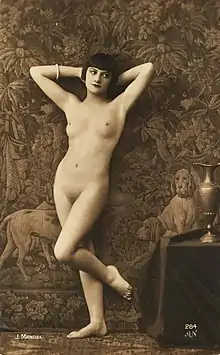
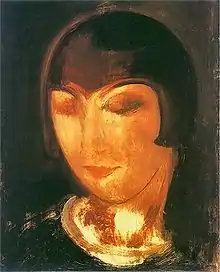
Early life
Alice Prin was born in Châtillon-sur-Seine, Côte d'Or. An illegitimate child, she was raised in abject poverty by her grandmother. At age twelve, she was sent to live with her mother in Paris in order to find work. She first worked in shops and bakeries, but by the age of fourteen, she was posing nude for sculptors, which created discord with her mother.

Notoriety begins
Adopting a single name, "Kiki", she became a fixture in the Montparnasse social scene and a popular artist's model, posing for dozens of artists, including Sanyu, Chaim Soutine, Julian Mandel, Tsuguharu Foujita, Constant Detré, Francis Picabia, Jean Cocteau, Arno Breker, Alexander Calder, Per Krohg, Hermine David, Pablo Gargallo, Mayo, and Tono Salazar. Moïse Kisling painted a portrait of Kiki titled Nu assis, one of his best known.
Her companion for most of the 1920s was Man Ray, who made hundreds of portraits of her. She can be considered his muse at this time, she is the subject of some of his best-known images, including the notable surrealist image Le violon d'Ingres[1] and Noire et blanche.[2]
She appeared in nine short and often experimental films, including Fernand Léger's Ballet mécanique without any credit.
Artwork and autobiography
%252C_Portrait_of_Kiki_de_Montparnasse_(Alice_Prin).jpg.webp)
A painter in her own right, in 1927 Prin had a sold-out exhibition of her paintings at the Galerie au Sacre du Printemps in Paris. Signing her work with her chosen single name, Kiki, she usually noted the year. Her drawings and paintings comprise portraits, self-portraits, social activities, fanciful animals, and dreamy landscapes composed in a light, slightly uneven, expressionist style that is a reflection of her easy-going manner and boundless optimism.[3]
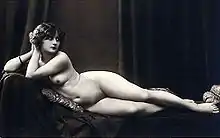
Her autobiography was published in 1929 as Kiki's Memoirs, with Ernest Hemingway and Tsuguharu Foujita providing introductions.[4] In 1930 the book was translated by Samuel Putnam and published in Manhattan by Black Manikin Press, but it was immediately banned by the United States government. A copy of the first US edition was held in the section for banned books in the New York Public Library through the 1970s. However, the book had been reprinted under the title The Education of a Young Model throughout the 1950s and 1960s (e.g., a 1954 edition by Bridgehead has the Hemingway Introduction and photos and illustrations by Mahlon Blaine). These editions were mainly put out by Samuel Roth. Taking advantage that the banning of the book meant it did not receive copyright protection in the U.S., Roth put out a series of supposedly copyrighted editions (which were never registered with the Library of Congress) which altered the text and added illustrations – line drawings and photographs – which were not by Prin. Editions published in and after 1955 include an extra 10 chapters supposedly written by Prin 23 years after the original book, including a visit to New York where she meets with Samuel Roth and Ernest Hemingway; none of this was true. The original autobiography finally saw a new translation and publication in 1996.[5]
Her music hall performances in black hose and garters included crowd-pleasing risqué songs, which were uninhibited, yet inoffensive. For a few years during the 1930s, she owned the Montparnasse cabaret L'Oasis, which was later renamed "Chez Kiki."[6]
A symbol of bohemian and creative Paris and of the possibility of being a woman and finding an artistic place, at the age of twenty-eight she was declared the Queen of Montparnasse. Even during difficult times, she maintained her positive attitude, saying "all I need is an onion, a bit of bread, and a bottle of red [wine]; and I will always find somebody to offer me that."
She left Paris to avoid the occupying German army during World War II, which entered the city in June 1940. She did not return to live in the city immediately after the war.
Death and legacy
Prin died in 1953 after collapsing outside her flat in Montparnasse,[7] at the age of fifty-one, apparently of complications of alcoholism or drug dependence. A large crowd of artists and fans attended her Paris funeral and followed the procession to her interment in the Cimetière parisien de Thiais. Her tomb identifies her as "Kiki, 1901–1953, singer, actress, painter, Queen of Montparnasse."[8] Tsuguharu Foujita has said that, with Kiki, the glorious days of Montparnasse were buried forever.
Long after her death, Prin remains the embodiment of the outspokenness, audacity, and creativity that marked that period of life in Montparnasse. She represents a strong artistic force in her own right as a woman. In 1989, biographers Billy Klüver and Julie Martin called her "one of the century's first truly independent women."[9] In her honor, a daylily has been named Kiki de Montparnasse.
Kiki was featured in a three-page obituary in Life magazine in the 29 June 1953 edition.
Gallery
- Kiki de Montparnasse by Julian Mandel
 Circa 1920
Circa 1920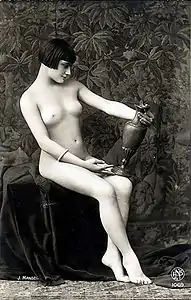 Jeune fille au vase between 1910-1930
Jeune fille au vase between 1910-1930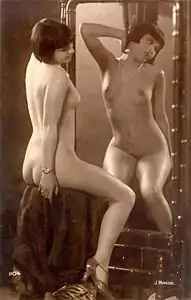 Postcard, c.1920
Postcard, c.1920 Postcard, Alice Prin, c.1920-30
Postcard, Alice Prin, c.1920-30.tif.jpg.webp) Postcard, Alice Prin, c.1920-30
Postcard, Alice Prin, c.1920-30
Filmography
- 1923 : L'Inhumaine by Marcel L'Herbier
- 1923 : Le Retour à la Raison by Man Ray, short film
- 1923 : Ballet Mécanique by Fernand Léger, short film
- 1923 : Entr'acte by René Clair, short film
- 1923 : La Galerie des monstres by Jaque Catelain
- 1926 : Emak-Bakia by Man Ray, short film
- 1928 : L'Étoile de mer by Man Ray
- 1928 : Paris express or Souvenirs de Paris by Pierre Prévert et Marcel Duhamel, short film
- 1930 : Le Capitaine jaune by Anders Wilhelm Sandberg
- 1933 : Cette vieille canaille by Anatole Litvak
Notes
- Le violon d'Ingres, Getty Museum
- Noire et blanche, Getty Museum
- "Kiki of Montparnasse" Archived 27 July 2009 at the Wayback Machine, Zabrieski Gallery
- "Kiki's Memoirs". Thefreelibrary.com. Retrieved 9 October 2013.
- Franke, Loui (2016). Parisian Postcards: Snapshots of Life in Paris. AuthorHouse. p. 22. ISBN 978-1-4567-6189-9.
- Jiminez, Jill Berk (2013). Dictionary of Artists' Models. Routledge. ISBN 9781135959142.
- Blume, Mary (12 June 1999). "Kiki of Montparnasse in the New York Times, June 12, 1999". The New York Times. Retrieved 9 October 2013.
- "Kiki (1901 - 1953) - Find A Grave Memorial". Findagrave.com. Retrieved 9 October 2013.
- Billy Klüver and Julie Martin, Kiki's Paris, Abrams, 1989
Further reading
- Kiki de Montparnasse (2007); by Catel & Bocquet (in French) Bruxelles: Casterman
- Kiki of Montparnasse (1968); by Frederick Kohner (a novel) London: Cassell ISBN 978-0-304-93242-9
- Kiki: Reine de Montparnasse (1988); by Lou Mollgaard (in French) Paris: Laffont
- Kiki's Memoirs (1996) translation by Samuel Putnam (original ed. pub by J. Corti, Paris)
- Kiki's Paris (1989); by Klüver and Martin. (French translation – Paris: Flammarion)
- Kiki's Memoirs, 1930 (2006) translation by N. Semoniff (in Russian – published by Salamandra P.V.V., 2011)
- Kiki Souvenirs, 1929 (2005) translation by N. Semoniff (in Russian – published by Salamandra P.V.V., 2011)
- Kiki's Memoirs (2009) [Recuerdos recobrados] translation by José Pazó Espinosa (in Spanish – published by Nocturna)
External links
![]() Media related to Alice Prin at Wikimedia Commons
Media related to Alice Prin at Wikimedia Commons